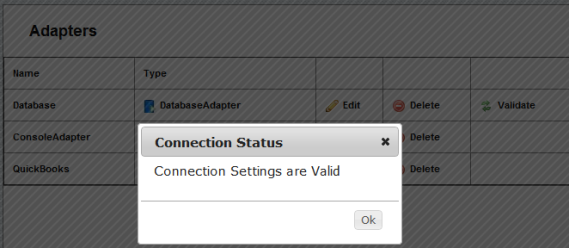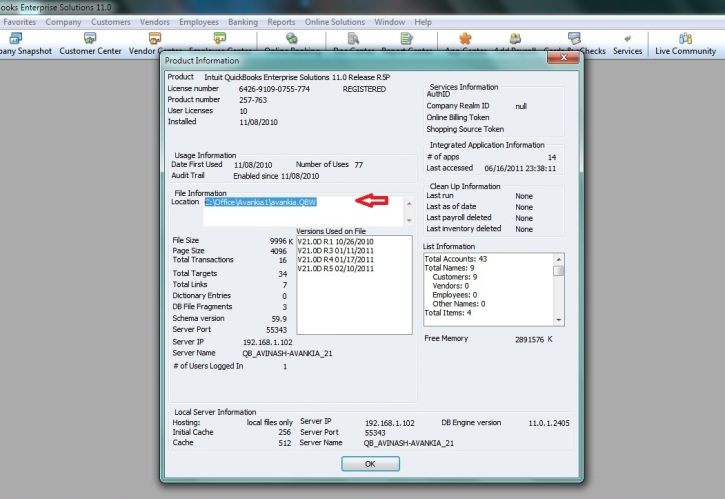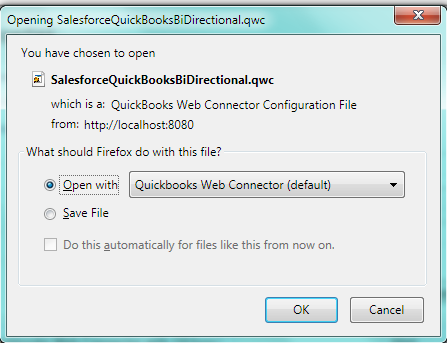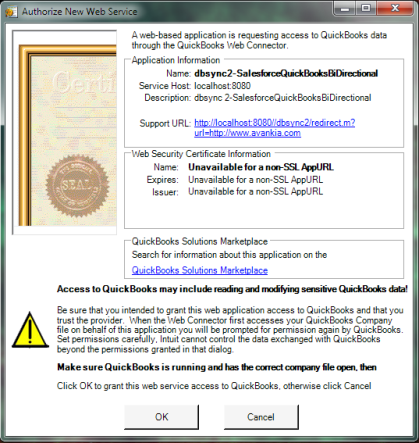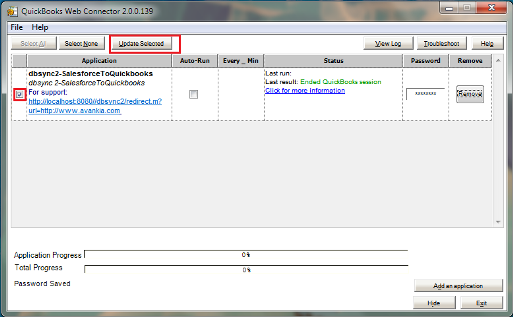2022
DBSync – Database to Quickbooks Integration
- Configure your Database for Integration with your Quickbooks file.
- For this Tutorial I will be using SQL Server Database Named "DBSyncDB" and 2011 US Edition of Quickbooks.
- Create tables "account" and "invoice" in Database with following script.
Database Script
USE [DBSyncDB] CREATE TABLE [dbo].[account]( [id] [varchar](20) NULL, [Name] [varchar](50) NULL, [phone] [nchar](20) NULL, [fax] [nchar](20) NULL, [billingstreet] [varchar](200) NULL, [billingcity] [varchar](50) NULL, [billingstate] [varchar](50) NULL, [billingcountry] [varchar](50) NULL, [billingcode] [varchar](50) NULL, [company] [nchar](100) NULL ) ON [PRIMARY] GO USE [DBSyncDB] CREATE TABLE [dbo].[invoice]( [invoice_no] [nchar](10) NULL, [customerid] [nchar](100) NULL, [item] [nchar](100) NULL, [itemdesc] [nchar](100) NULL, [quantity] [nchar](10) NULL, [uom] [nchar](50) NULL, [salesprice] [nchar](10) NULL, [total] [nchar](10) NULL, [billaddress] [nchar](100) NULL, [billingcity] [nchar](100) NULL, [billingstate] [nchar](100) NULL, [billingpostalcode] [nchar](10) NULL, [billingcountry] [nchar](100) NULL, [date] [nchar](50) NULL ) ON [PRIMARY] GO
* Make sure both the tables have sample data in them before they can be mapped within DBSync.
Database Setup
- Open www.mydbsync.com in your browser and click on Customer Login.
- Enter in your DBSync username and password to login.
- Once logged in, click on My Home from the menu and click on Launch button in the following page as shown.
- Once logged into the DBSync console, click on Create Profile button as shown below.
- You can use any naming convention for a profile as long as there are no white spaces in the name of the profile.
- Once the profile is created, click on Manage — Edit to configure the adapters.
- Click on the Create Adapter on the top left hand side of your window and select the required adapters from the drop down menu as shown.
- Enter the name for the adapter and select Database Adapter from the drop down. Click on Save button once done.
- Similarly, click on the Create Adapter button again to add Quickbooks Adapter to your DBSync profile.
- Once both the adapters are added, you will see them listed within the console page as shown.
- Now click on the Edit link next to the Database Adapter and enter your Database credentials as shown. In this tutorial, the database used is SQL Server 2005 and corresponding credentials are entered.
Note : If you are using a different Database server, you can enter the connection string for the same as shown here.
- Click on Validate link for the Database adapter. If the credentials entered are accurate, you will get a pop-up message saying the "Connection Settings are Valid".
- At this point you have successfully validated your Database Adapter.
Quickbooks Setup
- Click on the Edit link next to the Quickbooks adapter in the console page.
- Under the file section, enter the full path of your Quickbooks file as shown.
- You can retrieve full path / location of your Quickbooks file by pressing 'F2' key on your keyboard when in Quickbooks 'Home' page as shown below.
- Click on configuration Link at the bottom of the page. A Pop-up box will appear, prompting you to open the file with "QuickBooks Web Connector (default)", click on OK button as highlighted below in screenshot.
- Click on OK in the next window (first screenshot below) and on the next window select the option button "Yes, always; allow access even if QuickBooks is not running" and check the check box for "Allow this application to access personal data" and click on continue button (second screenshot below).
- In the Access Confirmation window click on the Done button as shown above . And the profile will get added to your QuickBooks Web Connector and a screenshot of the QuickBooks Web Connector is shown below.
- Please enter your DBSync password in the password section of the Web Connector and save it.
- At this point you have successfully completed configuring your Quickbooks with DBSync. You can run the integration by clicking on the Update Selected button.
Custom Mapping for Account and Invoice tables.
- Click on Manage — Edit to navigate to adapter configuration page.
- Click on Add Process Icon on the right-hand side of your screen. Enter Process Name and Click on Ok. A new process will be created and listed under profile name on the right side of the screen.
- Double-click on the Process Name "SyncProcess" or the one you have created with a desired name to navigate to the Process Builder Console. The process will contain 2 States by default:
- Start_state
- End_state
- Drag the Create State Button onto the control flow Area to create a new state. Enter the state name as "Execute" and click on OK Button. A new state will be created and placed on control flow area.
Click on [X] icon on Start_state to delete the default control flow from Start_State to End_state.
- Right Click\connect on Start_state followed by left click on Execute will create a control flow from Start_state to Execute. Right Click\connect on Execute followed by left click on End_state will create a control flow from Execute to End_state. All the control flows are displayed using arrows from one state to other state. Below you will find 2 screenshots one containing no control flow and second containing control flow as Start_state to Execute to End_state. Once done click on Save button at the top right corner of the window.
Overview
Content Tools







